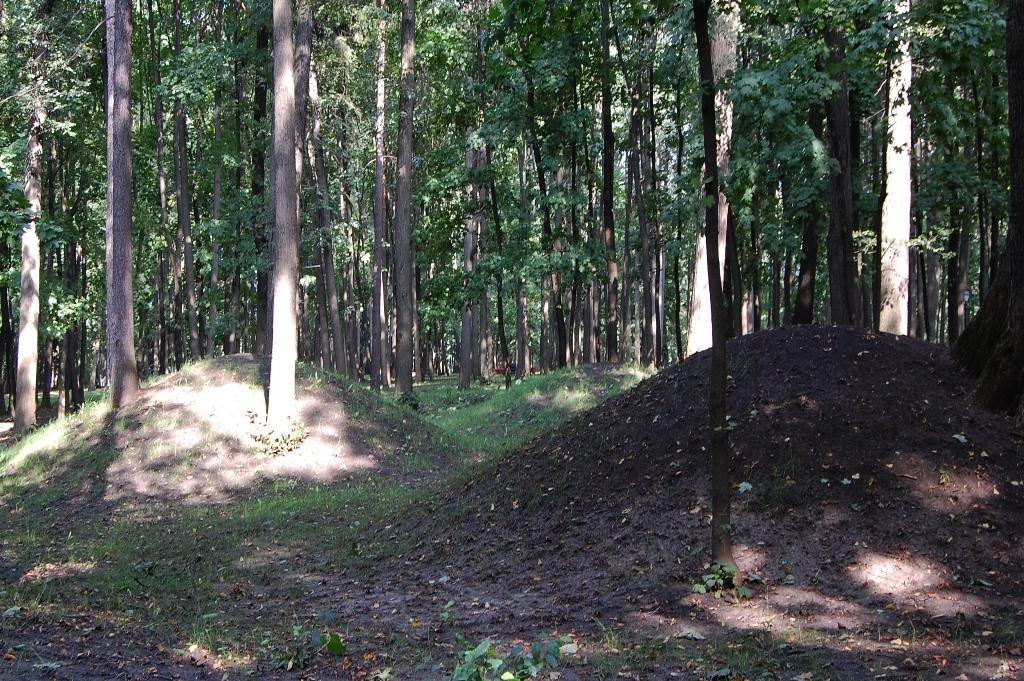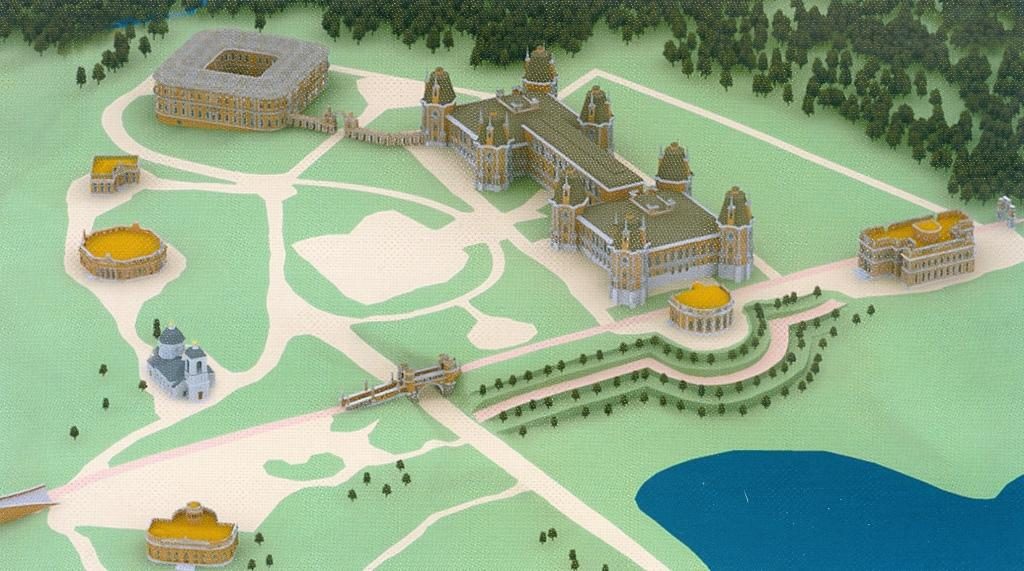History
About 4,000 years ago there was a Bronze Age settlement on the site of the future Tsaritsyno inhabited by tall cowherds with elongated faces. They made pottery with “zigzag” and “fir tree” patterns. In a couple of millennia they were replaced by businesslike men and women of the Iron Age. They spoke Finno-Ugric languages.
Later Vyatichi came to live in Tsaritsyno. They built underground huts, worshipped pagan gods and wore bright ornaments. Vyatichi buried their dead in mounds, some of them can still be seen in Tsaritsyno today.

From the 17th century, the future territory of the Tsaritsyno Museum – a place called Chernaya Gryaz (Black Mud) – belonged either to the Russian tsars or their favorites. Noble Streshnev, father-in-law of the first Russian tsar Mikhail Romanov, built a palace here. Tsar Aleksey Mikhailovich joined Chernaya Gryaz with his Kolomenskoye residence in Moscow. Later it was transferred to Vasily Golitsyn, Princess Sophia’s favorite, and his son Aleksei. The Golitsyns built a three-story multi colored palace with galleries, designed by a whole team of artists. The house was surrounded by a birch grove and a fruit garden.
After the coup d’état and accession of Peter I Golitsyans were exiled. Peter I gave Chernaya Gryaz to his ally in the Russian-Turkish war: the Moldovan ruler Dimitrie Cantemir. According to one of the guests, Cantemir built a new mansion “in Chinese style, with two-sloped roofs, with galleries, and with many small towers, open on all sides and covered only with canvas for freshness of air and protection from the sun. The mansion was made of wood.
In 1723 Chernaya Gryaz was transferred to Cantemir’s sons. In addition to magnificent wooden buildings, there were two fruit gardens and greenhouses with exotic fruits. The ambience was very rustic. This is exactly how Empress Catherine II found Chernaya Gryaz when she walked around it in the spring of 1775 with her son and daughter-in-law. Cantemir’s manor and picturesque landscapes excited the Empress. The deed was completed in just a week. At the end of May 1775, Ekaterina bought the estate and the surrounding villages for 30,000 rubles. During the summer of 1775 it was decreed to rename Chernaya Gryaz to Tsaritsyno.
In the summer of 1775 Catherine II repeatedly visited the new estate together with Grigory Potemkin. Court architect Vasily Bazhenov was assigned to design and build a new imperial residence “in accordance with the Gothic taste.” Bazhenov understood “Gothic” as a mix of ancient Russian architecture and the Moscow Baroque style.
Just as in the old days, Bazhenov used brick and white stone. He planned five palaces for the Empress and her family plus a whole range of buildings for the courtiers and servants, pavilions and decorative constructions. All of the buildings were of different geometric shapes and fit perfectly into the existing landscape. The architect tried to preserve the historical appearance and beauty of the old park.

Catherine II approved Bazhenov’s project. From 1776 to 1785 the work was underway in Tsaritsyno. However, there were difficulties with funding and construction materials. Bazhenov kept writing letters to state officials and even took out loans backed by his own property. On June 3, 1785, Ekaterina quickly inspected several halls of the Grand Palace and silently left, dissatisfied. The halls seemed too small and narrow to her.
However, in accordance with some scholars, the real reason for the Empress’ discontent was Bazhenov himself. The architect was close to the Masons and wrote regularly to the head of the Moscow Lodge Novikov. Novikov was a proponent of transferring the power from Catherine to her son, Prince Paul. The Empress saw conspiracy in all of this and decided to remove all the potential enemies from office, including Bazhenov.
Catherine II asked Bazhenov’s student and assistant Matvey Kazakov to continue works in Tsaritsyno. Kazakov disassembled the already completed main building and built a new palace with castle roofs and towers in its place.

In 1860 Emperor Alexander II decided to rent out the dilapidated palace buildings and land. That’s how a long period of country-house (dacha) construction began in Tsaritsyno. Writers, composers and artists used to spend summers here, so by the end of the 19th century Tsaritsyno became a prestigious dacha settlement.
At the beginning of the 19th century the park was renovated and the stone pavilions were built. Tsaritsyno became a popular place for taking walks in the countryside, something like a central park in the suburbs. Some of the buildings were repurposed to house a coffee shop or a hotel. One could have lunch and beer at some of the pavilions.

After the October Revolution dachas were nationalized and Tsaritsyno was renamed Lenino. “Communal,” multi-family apartments were organized in historical buildings.
In 1927 Tsaritsyno Museum of History and Art opened in one of the old buildings to celebrate the 10th anniversary of the October Revolution. It became quite popular: more than 20 thousand people per year came to see the collections of Bazhenov’s drawings and archeological finds from the burial mounds of Vyatichi.
But in the 1930s it was renamed Lenin Local History and Gardening Museum. The exhibition was changed to showcase Soviet agricultural achievements. Portraits and chandeliers were replaced by replicas of tractors and plows. After the “Harvest Day” and “Spring Seed Campaign” exhibitions were held, the museum started to rapidly lose popularity and was eventually closed. In 1936 Moscow authorities proposed to establish a holiday home at the palace and other buildings. However, these plans were never realized because of the World War 2.

During WW2 Tsaritsyno residents built the defensive lines. An anti-aircraft unit was disguised between the burial mounds. German planes hovered above the ruins of the Catherine’s buildings. Several bombs fell near the ancient pavilions. There were holes in the roofs of the summer cottages. Locals started growing carrots and cabbage around the Grand Palace, flower beds were replaced by potato beds.
In the postwar years Tsaritsyno buildings were occupied by the regional executive committee and the district archives, club and music school. In the end of 1960s, massive development of the Orekhovo-Borisovo district was launched. As a result, communal apartments in the old dachas were emptied and residents were relocated. A protection zone of more than 1000 hectares was established around the Tsaritsyno Palace.
In 1984 the State Museum of Decorative and Applied Arts of the Peoples of the USSR opened in Moscow. Its first director, artist Ilya Glazunov managed to transfer the whole of Tsaritsyno under the auspices of the new museum. A large-scale restoration project was designed at the workshops of Mosproekt-2 Institute.

In 1986, the Ministry of Culture of the USSR signed a contract with the Polish government company “Workshops for Restoration of Antique Monuments.” From 1987 to 1995 Russian and Polish specialists restored almost everything; only the Grand Palace and the Bread House remained dilapidated. The park and pavilions also needed improvement. These works were conducted from 2005 to 2007.
On September 2, 2007 the restored Tsaritsyno officially opened and started a new life.

